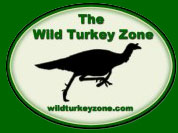|
3,112 - Spring 2005
2,944 - Spring 2004
3,591 - Spring 2003 ---- 208 - Fall 2002
The 2005 Spring Gobbler
Season will go on the books as being the
third best since turkey hunting began in 1981.
Between the April 16 youth turkey hunt and
the May 27 season finale, hunters bagged 3,112
male wild turkeys, according to Tony McBride,
a biologist with the state Division of Fish
and Wildlife.
The numbers reveal wild turkeys
are thriving all across the state. But they
show the birds are doing particularly well
in South Jersey. "Turkey
hunting areas in northern parts of the state
were more affected by poor productivity conditions
during the past few years and most of these
areas showed slight decreases in harvest,"
says Fish and Wildlife's report on the season.
"Most turkey hunting areas in southern
New Jersey, however, showed marked increases
in harvest, probably due to better productivity
in those areas."
New Jersey is a relatively
small state that doesn't cover a huge north-to-south
chunk of the continent (think California).
Still, there seems to be enough of a difference
in climate to have an effect on turkey health.
"It's just a theory,"
McBride said. "But that area, including
Salem, Gloucester, Cape May and Cumberland
counties, rarely has bad turkey hatches. The
conditions that cause high poult mortality
are usually long periods of cool temperatures
and rain. The best I can gather is that, when
we have a cool rain event up in Northern New
Jersey, where it's in the 50s, oftentimes
in the South it will be raining, but it will
be in the low 60s."
Those few degrees might be
just enough. "I have no data to support
that," McBride said. "I just know
it's usually a little warmer down there when
we have a rain event and it seems as though,
in the long run, they averaged better in southern
New Jersey than in northern New Jersey."
He said Fish and Wildlife
is very happy to see a payoff on its efforts
to boost the turkey population in Cape May
County. "That was an area we focused
on for many years by having supplemental increases,"
McBride said. "The turkey population
in Cape May has taken off and I'm really glad
to see that."
So what's in store for next
year's gobbler hunt? McBride believes this
spring's weather was ideal for turkey reproduction
and survival. "I've gotten several good
reports of poult sightings," he said.
"We had two or three days of mostly cloudy
weather at the end of May, but the bulk of
the hatch occurred after that."
Poult production in spring
2004 was also good, so McBride predicts the
high number of juveniles running around the
woods this year "will translate into
a lot of 2-year-olds available for the 2006
season."
|

